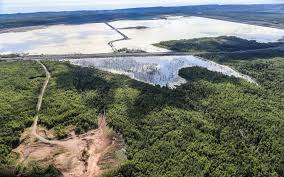On February 3rd the Minnesota Court of Appeals, in a unanimous decision, reversed an earlier court decision that denied the need for an Environmental Impact Statement (EIS) on the proposed expansion of the Mile Post 7 tailings dam. The Mile Post 7 dam is located directly above the cities of Beaver Bay and Silver Bay and is a designated class 1 hazard level dam. Northshore Minning’s plan was to expand the tailings pond by using an upstream dam design. Upstream dam designs have been banned in countries like Peru, Chile and Brazil due to catastrophic dam failure that brought about large scale destruction and loss of life. Local communities and environmental groups have expressed concern that the proposed Mile Post 7 expansion could potentially cause severe harm to human life, property and the environment in the event of a dam breach..
Though upstream dams are cheaper to build than other types of dams, they are more dangerous because their walls are constructed over a base of muddy mining waste rather than being constructed on more solid ground. The plan for the Mile Post 7 expansion, up to this point, has called for increasing the height of the existing dams. Northshore Mining apparently hoped to get around the EIS requirement by claiming that the project was not an expansion. It seems that the Minnesota Court of Appeals didn’t buy that argument.
WaterLegacy Executive Director and Counsel, Paula Maccabee said in a statement, “This is an important victory. The Court’s ruling rejects Northshore’s claims that its massive tailings dam expansion is exempt from environmental review. It puts DNR on notice that previous environmental review and permitting is not a ‘get out of jail free’ card to avoid scrutiny of a proposed mining project. The Court’s decision gives DNR a new opportunity to require an EIS and an open and public Dam Safety permit process to protect Beaver Bay, Silver Bay, and Lake Superior from Mile Post 7 tailings dam failure. Lake Superior waters, Tribes, and all North Shore communities deserve an open public process to prevent Mile Post 7 catastrophic release of toxic tailings sludge and wastewater.”
In previous articles written about this matter, the Northshore Journal sought out officials at both Cleveland Cliffs and Northshore Mining for comment. No one responded to our requests. At the time of our initial inquiries to company officials, we also asked members of the public for their thoughts about the dam expansion. The majority of respondents wanted to hear directly from company officials so that they could learn about dam monitoring and safety measures, environmental impacts, and construction parameters for the proposed expansion.



